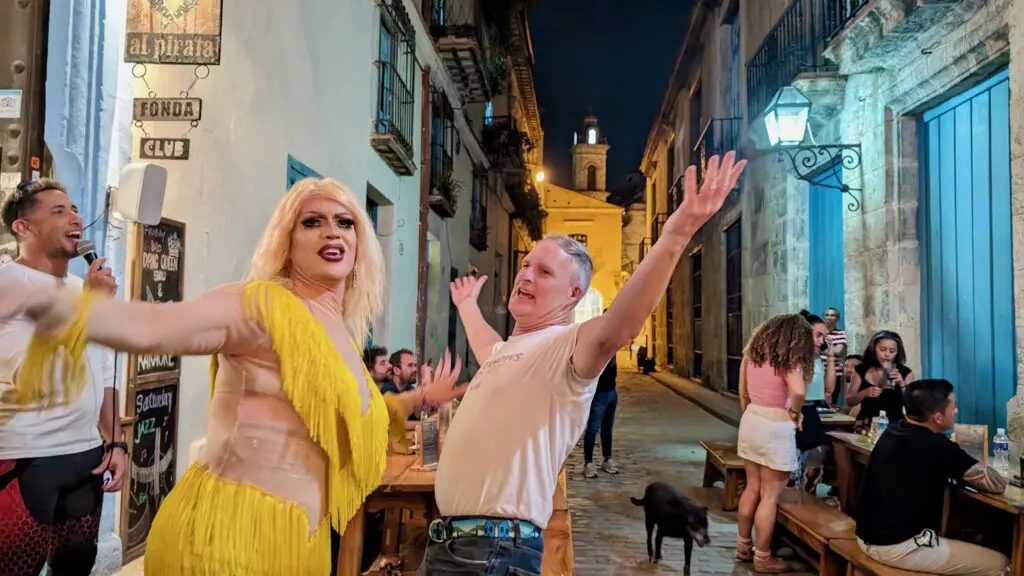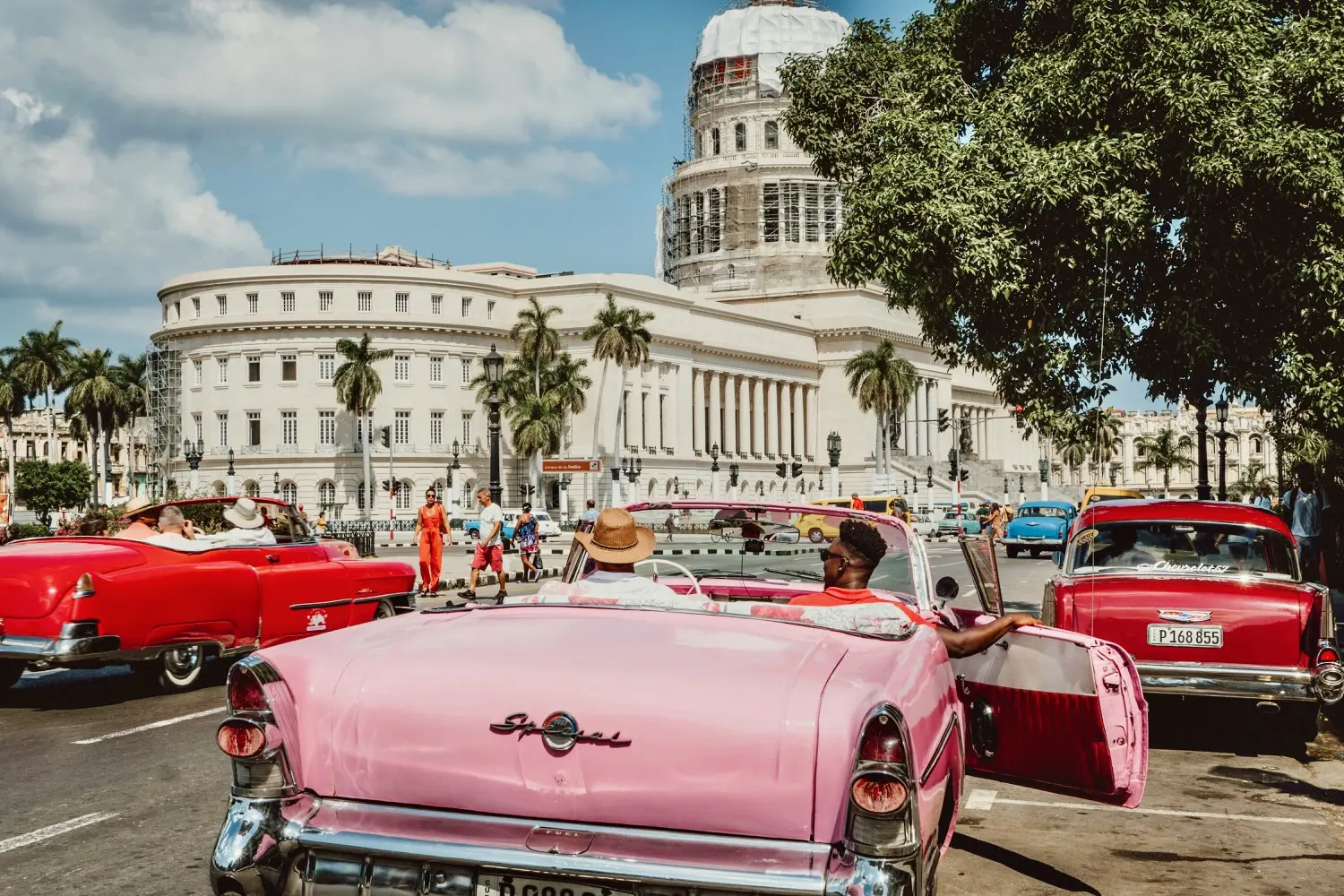For Americans and Canadians alike, the tropical isles of the Caribbean are playgrounds of sand and sun, filled with laid-back vibes, joyful steel drum melodies, and the fruitiest of frozen drinks. Though Canadians have enjoyed the privilege of freely traveling to the Caribbean’s largest island, Cuba, it’s a different story for Americans, who face a fair bit of red tape should they desire a sizzling night out in Havana. Read on to find out if a gay tour to Cuba is right for you!

Can Americans Travel To Cuba? Yes. And if you’re looking for all the information and rules on how to do that, click here.
Americans who travel to Cuba typically do it on a Support For The Cuban People tour. But what does that mean?
Support For The Cuban People means that travellers must maintain a full-time, documented itinerary (8 hours per day) of participating in cultural exchanges, visiting Cuban-owned museums, galleries, businesses, and restaurants, as opposed to those owned by the government. These tours encourage and empower Cuban entrepreneurs, artisans, and grassroots initiatives while facilitating mutual understanding and positive relations between visitors and locals.

But… why?
Long story short, the US government does not want Americans spending money that goes toward supporting the Cuban government, but will allow Americans to spend money supporting the Cuban people.
Imagine that the US and Cuba were a couple whose initially-happy relationship began with the Treaty Of Paris in 1898. Cuba officially broke up with the US in 1959 and started seeing other countries, namely the Soviet Union, leading to the Cuban Missile Crisis in 1962. ¡Escandelo!

The US, having soured on Cuba, cut it off altogether and forbade US citizens from Cuban travel. It’s worth mentioning that Canada, a staunch ally to both the US and Cuba, stayed out of the conflict and maintained positive relations with both countries.

In the early 2010s, nearly 50 years after the Missile Crisis that set off a decades-long conflict, the US and Cuba began speaking again, leading to President Barack Obama’s 2014 visit to the Pearl of the Antilles. But maintaining diplomacy wasn’t quite that easy, as a change in US administration brought a change in outlook on Cuban relations.

Today, the US recognizes that it’s unfair to hold the Cuban people personally responsible for the past 60+ years of conflict, and has enacted policies which allow Americans to travel to Cuba on Support For The Cuban People tours. Historical baggage aside, American travellers will find Cuba to be a welcoming and vibrant nation chock full of classic cars and aromatic cigars, where the US dollar goes further than they might expect.
Southern Hospitality, Cuba-style!
Farther south than any of the contiguous US, hospitality is a mainstay of Cuban culture, and part of Support For The Cuban People tours involves slumbering at local homestays known as casa particulares. These family-run guesthouses provide an authentic glimpse into daily life, as well as insights into Cuban culture and traditions. Most homestays are the equivalent of boutique hotels, except more personalized and with fewer frills, allowing guests to contribute directly to the local economy and gain a richer understanding of the island’s way of life.


The genuine warmth of Cuban hospitality can be felt immediately upon arrival, as visitors will find themselves treated not as guests, but as extended members of the family. Most Cubans take pride in sharing their culture by introducing their new friends to the fiery rhythms of salsa music, the fab flavors of Cuban cuisine, and finest cigars the island has to offer.

Live Like A Cuban
The unique Afro-Cuban culture is prevalent just about everywhere we’ll go, but especially in Trinidad, a charming town on the southern coast. A stroll through Plaza Mayor will seemingly take you back in time, as both the traditions and architecture of centuries-past are well-preserved.

Here, we’ll indulge in a highlight of the trip with a stop at Casa Temple de Santeria Yemayá, an 18th-century house dedicated to the deity of the sea, Yemayá. This religious temple and house symbolizes the historical significance of the Afro-Cuban culture and identity with a focus on Santeria, the syncretic religion that developed among West African descendants in the Caribbean.
Santeria originated from when African slaves were brought to the Caribbean and forced to adopt Christian beliefs. However, instead of rejecting their own Gods, they disguised them as Christian “Saints” (Santos) and continued worshiping them under the guise of Catholicism.


This fascinating religion involves sacred drumming, dance, a trance system for communicating with ancestors, and animal sacrifice – a level of drama that Ru Paul’s Drag Race can only aspire to.
Dance Like A Cuban
After we’ve had our fill of juicy Santeria rituals, it’s time to learn new ways to move our hips at an LGBTQ-instructed salsa dancing class.

Whether you have experience or not, our local instructor will expertly guide you through the ins, outs, twists, and shouts of this locally-pioneered, fluid and flamboyant style. Once we’ve added “salsa dancer” to our gay cards, a celebratory cigar will be in order.
Smoke Puros (Cigars) Like A Cuban
Widely seen as a symbol of success, Cuban cigars, or Puros as they’re called due to being rolled purely with Cuban leaf, are a staple of the culture that also accounts for one-quarter of Cuba’s exports.

Remember that Missile Crisis back in ‘62? President John F. Kennedy placed a last-minute order for Puros right before all trade with Cuba was suspended, which speaks to how coveted they’ve historically been amongst the aristocracy.

The epic landscape of Viñales provides a striking backdrop to our visit to the cigar farm, where we’ll learn about the process from planting tobacco to rolling the final cigar from a farmer and expert cigar maker. Along the way, we’ll learn how the communist system works, how much tobacco they will keep, and how much they’ll give back to the government. And of course, we’ll celebrate by lighting up our own fat Cuban stogies. For those who’ve never smoked a cigar, this experience will be akin to your first taste of champagne being Cristal.

Cuban Art
Connoisseurs of the art world are likely familiar with renowned artists Armando Mariño, Yoan Capote, Carlos Estévez, Alicia Leal, and many more. These famous Cuban painters, sculptors, and contemporary artists serve as an inspiration to fellow artists we’ll meet along our journey.

In Cienfuegos, we’ll visit an art collective where artists share studio space, materials, ideas, and knowledge with one another. The adjacency of the collective helps to form and flesh out new ideas, and creates an environment where up-and-coming artists have access to the tools they need to learn, create, and exhibit their own works.


In Havana, we’ll stop in the suburb of Jaimanitas, made famous by artist Jose Fuster. His home, Fusterlandia, is a living art project entirely covered in eclectic mosaics. We’ll also delve into the colorful concrete walls of Hamel Alley, located in central Havana, where we’ll learn about local graffiti artists and their stories, history, and contributions to Cuban culture. Both of these stops will be some of the most Instagrammable sites on our tour, so keep those cameras handy!

LGBTQ+ Activism On Our Support For The Cuban People tour
Like many places in the world, Cuba was historically anti-LGBTQ+ due in part to machismo, a strong sense of exaggerated masculinity and self-reliance inherent to Latin American culture. The 1990s saw a rapid liberalization of Cuban culture centralized in Havana, and as of September 2022, discrimination on the basis of sexual orientation and gender identity is illegal in Cuba, a goal that LGBTQ+ activists have worked toward for decades.

While in Havana, we’ll have the privilege to meet with an LGBTQ+ activist group at a gay-run community theater. This opportunity to better understand the ongoing fight for LGBTQ+ rights will allow us to gain insight into the history, goals, and tactics of opening hearts and minds in a country where religion, machismo, and traditional gender roles are still widely espoused. We’ll come away from the meeting with new friends and a new perspective on an ongoing battle that is far from over.


Extravagance is rarely found in Cuba, however authenticity is everywhere you look, and the distinctive character of this vibrant island nation always finds a way to latch on to the souls of those who visit. Our Support For The Cuban People tours are designed to satisfy the requirements and documentation for Americans to visit legally, as well as provide a comprehensive perspective on Cuban art, cuisine, history, and daily life.
If you’re interested in joining our Cultural Cuba tour or our Cuba: New Year Fiesta, either fill out a booking form or Contact Us to reserve your spot. See you in Cuba!
Featured Posts
Visiting Cuba is an exciting albeit confusing proposition. There are a lot of questions worth asking, and some answers are more complicated than others, but we’ve done our best to tackle them all here. Read More
Cuba's vintage cars, fragrant cigars, vibrant architecture provide a tropical backdrop for our cultural tours. Check out the highlights! Read More
After some back-and-forth emailing, our local Cuba guide introduces himself, offers a covid update, discusses gay life on the island and shares his favourite Cuban sites and cities. Read More
